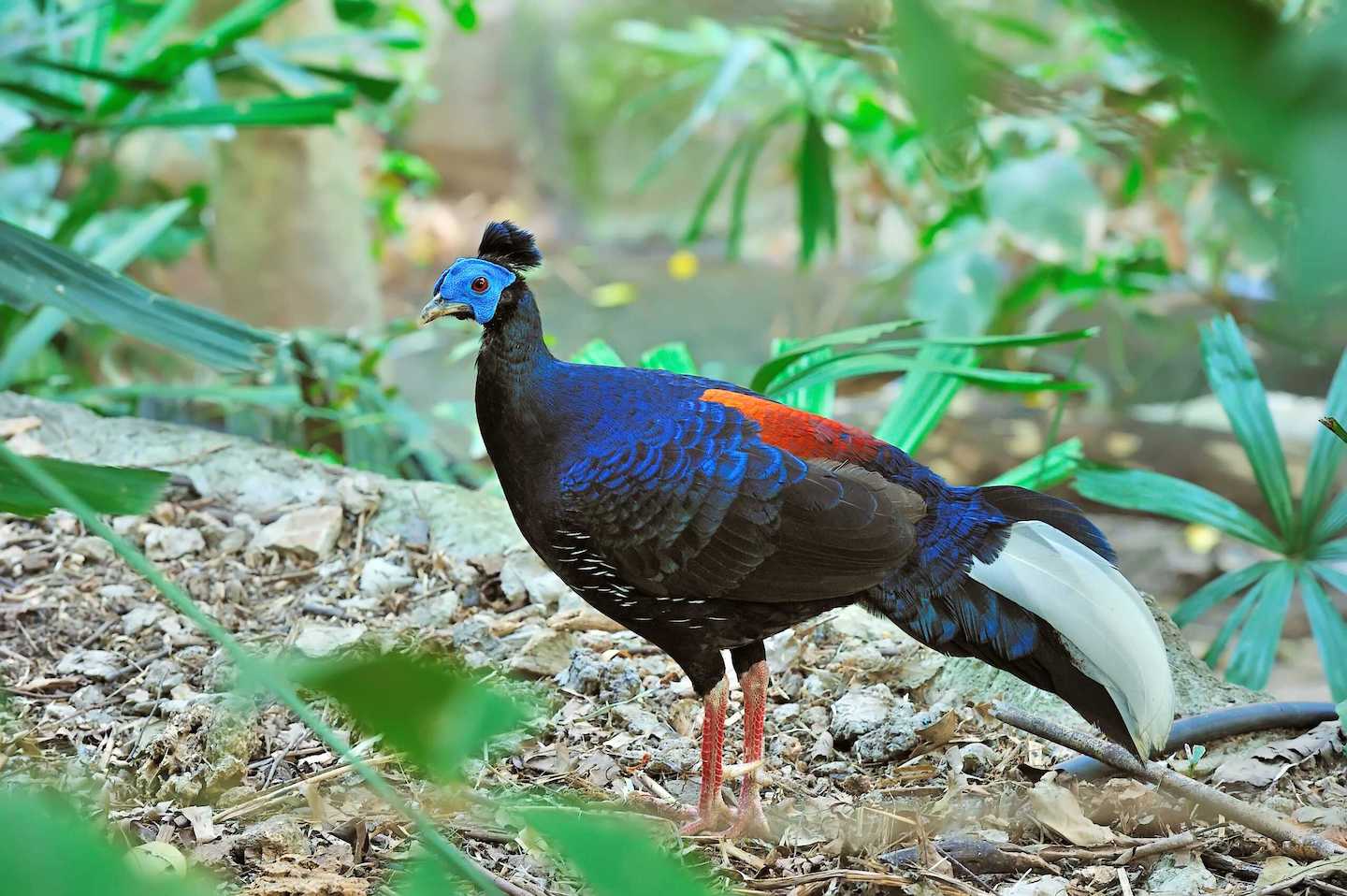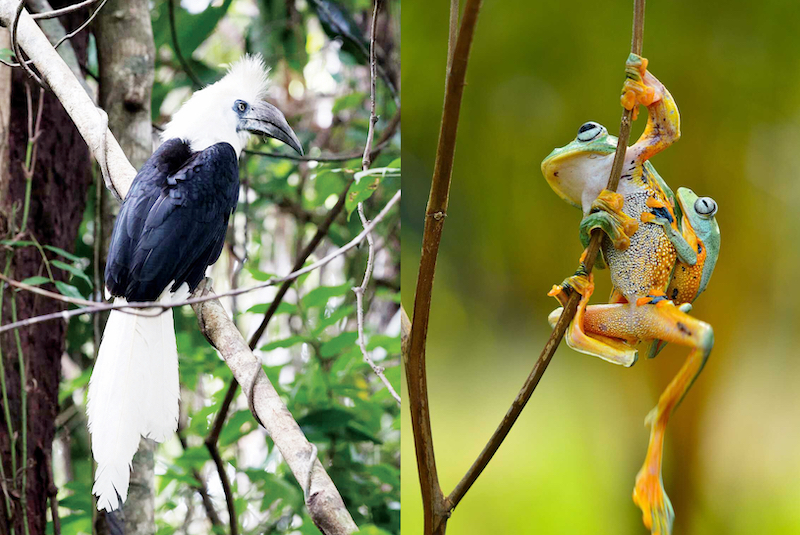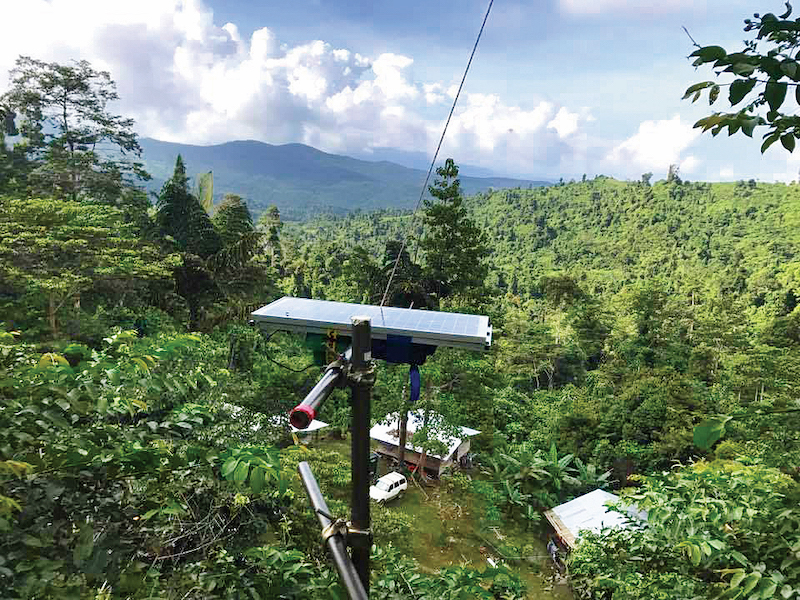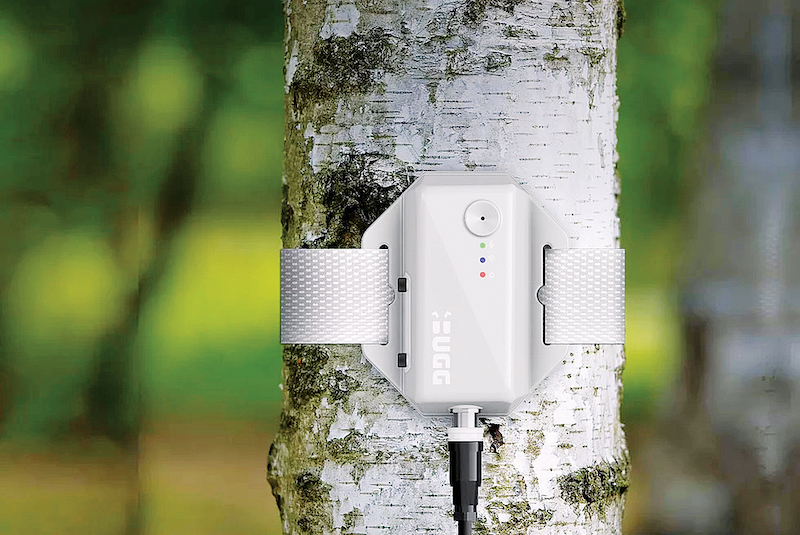
The crested fireback, a forest pheasant with a peacock-like dark crest mostly found in Borneo and Sumatra, is labelled 'vulnerable' on the International Union for Conservation of Nature list (All photos: SAFE Acoustics)
The bright plumage of birds makes the human tribe look banal by contrast. Smart and seductive, these feathered creatures beckon their potential mates to appraise the home they have constructed with flamboyant courtship techniques that even humans have yet to perfect. Giving their intellect short shrift was perhaps a mistake, especially when avian intelligence has not been well established.
The Bornean rainforest is home to an intriguing array of winged curiosities. Chestnut-necklaced partridge and short-toed coucals partake in a symphony with their lilting whistles and melancholic hoots respectively, punctuating a still jungle overgrown with flora of remarkable abundance. But their voices will be muffled in no time as these species are rapidly sliding towards extinction on the International Union for Conservation of Nature (IUCN) list. The exploitation of nature with abandon through illegal logging, and decimating natural habitats across the planet, has thrown ecosystems so out of whack that the domino effect has backfired on humans.
befunky-collage.jpg

Mediators of global water cycle and cradles of biodiversity, tropical rainforests are home to half of the world’s plants and animals, many of which have yet to be catalogued. Wildlife monitoring is one way for scientists to ensure biodiversity conservation but the traditional method of recognising animals by sight or sound — although tried and tested — has proved to be slow, expensive and susceptible to human biases.
Thus, the researchers behind SAFE Acoustics have decided to rely on a readily available barometer of environmental health: the sound of animals. Led by a cadre of scientists from Imperial College London, Universiti Malaysia Sabah and the South East Asia Rainforest Research Partnership (SEARRP), the interdisciplinary research project has developed real-time acoustic monitoring units and deployed them in a network across varying levels of forest degradation at the Stability of Altered Forest Ecosystems (SAFE) Project, one of the largest ecological experiments in the world, based in Maliau Basin, Sabah. Some of the recorders were placed in primary forest largely untouched by humans, others in logged forests and commercial oil palm plantations.
main_photo_safe_acoustics_has_developed_a_robust_real-time_and_autonomous_monitoring_of_ecosystems_.jpeg

In 2017, Dr Sarab Sethi, a researcher at the Norwegian Institute for Nature Research (NINA) and a visiting academic at Imperial College London, developed an adaptable and inexpensive recording device that could upload data from the field. His research supervisor Prof Robert Ewers (also founder of the SAFE Project) — who first toyed with the idea of real-time acoustic monitoring — sent Sarab to test out his device in Sabah as part of his PhD research. Only one or two devices were set up at first but after a few rounds of upgrades and improvements, nearly 15 devices have been deployed across the site since 2018.
“The recorders are powered by solar panels so they are able to run indefinitely without battery replacements. Once the data [uploaded via a mobile internet connection] reaches our servers, it is analysed by machine learning techniques, which identify keystone species with uniquely identifiable calls such as the Bornean Gibbons. We can also look at how the overall soundscape has changed or if there were any anomalous events such as the sound of gunshots or chainsaws from illegal activity. The data is then presented in a web dashboard, which enables us to monitor the network in real-time,” explains Sarab.
SAFE Acoustics can also be used to predict ecosystem health at a much faster rate because it replaces time-consuming “point count” field surveys, in which highly trained specialists manually track down animals or set traps for insects to identify the shapes and patterns on their bodies. Although not all animals can be monitored this way (since some of them do not make sounds), the audio monitoring still offers a high-level overview of the state of the forest.
dr_sarab_sethi.jpg

Each site is surveyed at least twice in every hour of the day to make sure the researchers do not miss out on any animals with unusual waking hours. To date, SAFE Acoustics has recorded more than 120 species of birds, as well as over 40 types of frogs and reptiles. Keen naturalists can listen to their sounds by visiting the project’s interactive map, which lists the type of species that may be spotted at a specific time.
Bioacoustics technology, which has taken flight in countries such as Puerto Rico and Australia, has led scientists to discover deadly amphibian ailments by monitoring the decline in frog calls; track poaching by listening for gunshots; and identify animal reproductive pattern changes in response to climate change through vocalisations. How will the collected data help preserve biodiversity in the Bornean region?
“At SAFE, we look at how different oil palm management practices [such as the use of riparian buffers or a vegetated area near a stream that partially protects it from the impact of adjacent land uses], different logging intensities and different forest fragment sizes affect biodiversity. For example, if we find that 100ha of forest patches left in a predominantly oil palm landscape preserve 80% of the biodiversity found in ancient old growth forest, but 10ha of forest patches only keep 20%, we can then plan new plantations with the optimal layout of preserved forest areas. Similarly, if we find that there is a certain logging intensity above which biodiversity declines suddenly, we can advise policymakers to allow certain safe pressures only.”
sarab_is_also_the_project_leader_of_bugg_the_new_intelligent_eco_acoustic_monitoring_system_.jpg

Collecting data and developing electronics in rainforests, which are constantly impeded by heavy rain, high humidity and low levels of internet connectivity, are arduously tricky. A professional team needs to carry heavy rope bags for hours, wade through dense canopies and climb towering trees to reach their sampling sites. These are risky but necessary steps that will hopefully contribute to giant leaps in conservation as well as environmental policymaking that protects the country’s economic growth and safety of local communities.
“The tropical forests of Borneo are some of the most biodiverse regions on earth. But they are also some of the most threatened by large-scale agriculture, primarily from logging and oil palm plantations. If you are looking to monitor and understand biodiversity loss, there is few more urgent needs than in Borneo,” Sarab reasserts.
Nature has spoken, and with the aid of technology, we can hear its response more clearly than ever. Losing a species is akin to pulling a wooden block from a Jenga game — the more pieces disappear over time, the sooner the tower of biodiversity, which Mother Earth depends on, collapses.
Listen to more audio recordings of Bornean forests here.
This article first appeared on Jul 27, 2021 in The Edge Malaysia.


